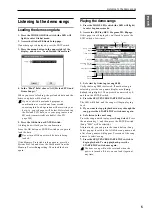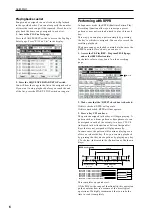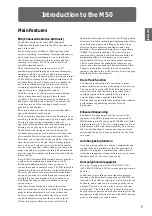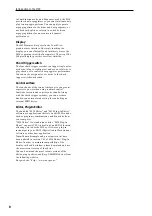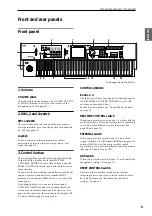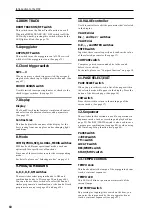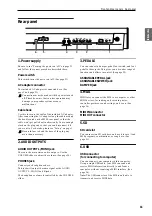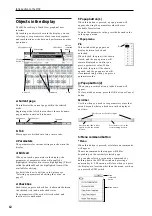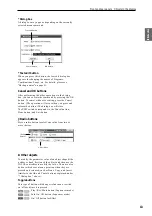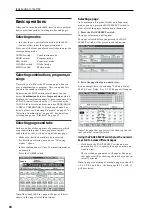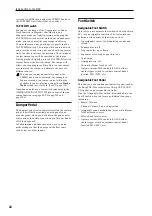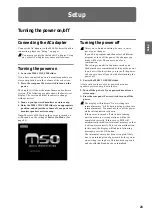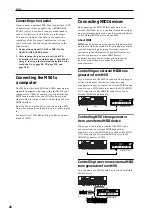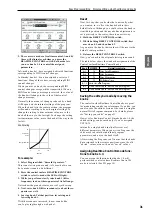
Basic Information Using Controllers
19
Introduction
Program
Combination
Sequencer
Effect
Arpeggio
Drum Track
Global
Media
When selecting a program or combination number in a
dialog box, you can also use the BANK SELECT switch
to enter the bank as an alternative to using the VALUE
controllers.
4. To execute, press the OK button or the ENTER
switch.
If you decide not to execute, press the Cancel button or
the EXIT switch.
The dialog box will close.
Writing/saving
After editing, you should write or save your changes
as necessary.
For example if you’ve edited a program, your changes
will be lost if you select another program or turn off
the power. The same applies to a combination.
Settings you edit in Global mode will be remembered
as long as the power is on, but your changes will be
lost when you turn off the power, unless you write
these changes into memory.
For details on the Write operations, see the following
pages.
• Programs
• Combinations
• Effect presets
→
PG p.77
• User arpeggio pattern
• User Drum Track patterns
→
PG p.208
Preset/user Drum Track patterns are saved in
internal memory even when the power is turned
off. Patterns you create in Sequencer mode can be
converted into user Drum Track patterns and saved
in internal memory.
• User template songs
→
PG p.192
Preset/user template songs are saved in internal
memory even when the power is turned off. Track
settings and effect settings of a song you create can
be saved in internal memory by the menu
command Save Template Song.
• For details on writing to internal memory
Refer to the following pages for more about saving.
• Saving to media (Media– Save)
Note:
On the M50, the action of writing to internal
memory is called “Write,” and the action of saving to
an SD card device is called “Save.”
Assigning a name (renaming)
You can edit the name of an edited program,
combination, song, drum kit, or arpeggio pattern.
You can also change the names of the program and
combination categories.
For details, please see “Editing names” on page 91.
Using Controllers
In addition to using the keyboard, the M50 lets you
control the sound by using the joystick, SW1 and SW2
switches, knobs 1–4, chord trigger switches, damper
pedal, and foot switch or foot pedal.
These controls let you modify the tone, pitch, volume,
effects, etc. in realtime as you play.
Joystick
The joystick moves in four directions: left, right, up
(away from yourself), and down (towards yourself).
Each of the four directions can be used to control a
different function, such as modulating Program or
effects parameters. These assignments can be different
for every Program, but generally, they do the
following:
Standard Joystick functions
Joystick Lock
The joystick will automatically return to the center
position when you release it.
You can use the SW1/SW2 switches or a foot switch
connected to the M50 to lock the current position so
that the effect will continue even after the joystick
returns to the center position. For details, please see
“Using the Lock function” on page 20.
SW1, SW2
You can use these switches to control program
parameters via AMS (Alternate Modulation), or effect
parameters via DMod (Dynamic Modulation).
They can also transpose the keyboard by octaves, turn
portamento on/off, or to lock the position joystick.
Each switch can work as either a Toggle or Momentary
switch. In Toggle mode, the assigned function is
switched between on and off each time the switch is
pressed. In Momentary mode, the assigned function is
active on only as long as you hold down the switch.
In Program mode, you can check the assignments of
SW1 and SW2 on the Prog P0: Play– Main page.
Move the joystick…
Controller
Name
Normally controls…
Left
JS–X
Pitch bend down
Right
JS+X
Pitch bend up
Up (away from yourself )
JS+Y
Vibrato
Down (towards yourself )
JS–Y
Filter LFO (wah)
1
2
(Lock
function)
Joystick
SW1 and SW2
Содержание EASYSTART M50
Страница 1: ...3 E Owner s Manual ...
Страница 84: ...Arpeggiator function 78 ...
Страница 88: ...Drum Track function 82 ...
Страница 92: ...Settings for the entire M50 86 ...

